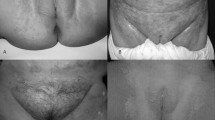Abstract
Abstract
The diaper environment increases the coefficient of skin friction and compromises the function of the stratum corneum. In this study, the tribological and mycological benefit of the use of a miconazole nitrate-containing paste on diapered skin was evaluated. A total of 135 instrumental measurements of both erythema and stratum corneum alterations were made on alternate days for 3 weeks in 15 infants. Biometrological parameters were the chromacity a* of the skin and the squamometry index. Cultures testing forCandida albicans were also performed. In the days following the use of the paste, the chromacity a*, the squamometry index and the number of positive cultures ofC. albicans were significantly reduced compared to the same evaluations made off treatment.
Conclusion
Miconazole nitratecontaining paste reduces the tribological interference between cloth diapers and skin as well as providing the diapered skin with an improved microbial environment.
Similar content being viewed by others
References
Benjamin L (1987) Clinical correlates with diaper dermatitis. Pediatrician 14 [Suppl 1]:21–26
Berg RW (1987) Etiologic factors in diaper dermatitis: a model/for development of improved diapers. Pediatrician 14 [Suppl 1]:27–33
Berg RW (1988) Etiology and pathophysiology of diaper dermatitis. Adv Dermatol 3:75–98
Berg RW, Buckingham KW, Stewart RL (1986) Etiologic factors in diaper dermatitis: the role of urine. Pediatr Dermatol: 102–106
Berg RW, Milligan MC, Sarbaugh FC (1994) Association of skin wetness and pH with diaper dermatitits. Pediatr Dermatol 11:18–20
Buckingham KW, Berg RW (1986) Etiologic factors in diaper dermatitis: the role of feces. Pediatr Dermatol 3:107–112
Piérard GE, Piérard-Franchimont C (1994) Squamometry as an aid for rating severity of target lesions in atopic dermatitis. Giorn Int Dermatol Pediatr 6:125–128
Piérard GE, Piérard-Franchimont C, Saint Léger D, Kligman AM (1992) Squamometry: the assessment of xerosis by colorimetry of D-Squame adhesive discs. J Soc Cosmet Chem 47:297–305
Piérard GE, Arrese JE, Dowlati A, Daskaleros PA, Rodriguez C (1994) Effects of softened and unsoftened fabrics on infant skin. Int J Dermatol 33:138–141
Piérard GE, Arrese JE, Rodriguez C, Daskaleros PA (1994) Effects of softened and unsoftened fabrics on sensitive skin. Contact Dermatitis 30:286–291
Zimmerer RE, Lawson KD, Calvert CJ (1986) The effect of wearing diapers on skin. Pediatr Dermatol 3:95–101
Author information
Authors and Affiliations
Rights and permissions
About this article
Cite this article
Piérard-Franchimont, C., Letawe, C. & Piérard, G.E. Tribological and mycological consequences of the use of a miconazole nitrate-containing paste for the prevention of diaper dermatitis: an open pilot study. Eur J Pediatr 155, 756–758 (1996). https://doi.org/10.1007/BF02002901
Received:
Accepted:
Issue Date:
DOI: https://doi.org/10.1007/BF02002901




